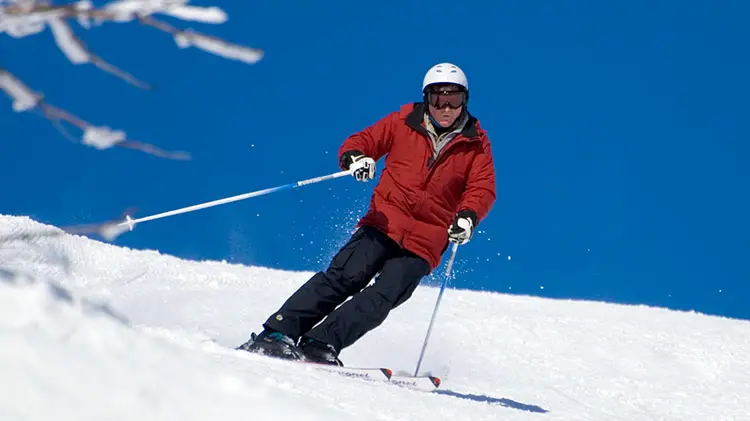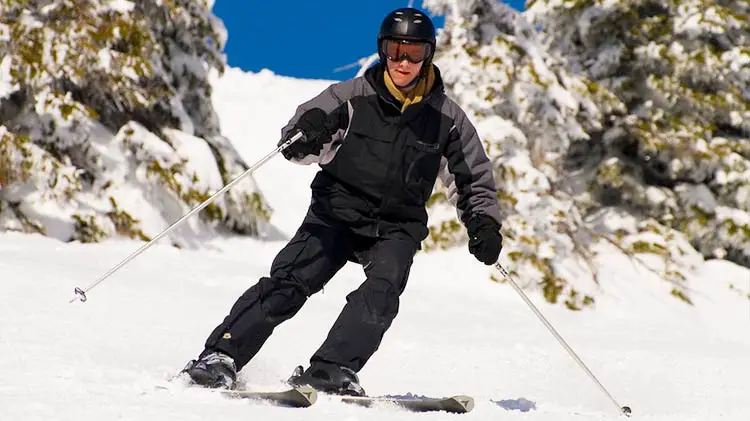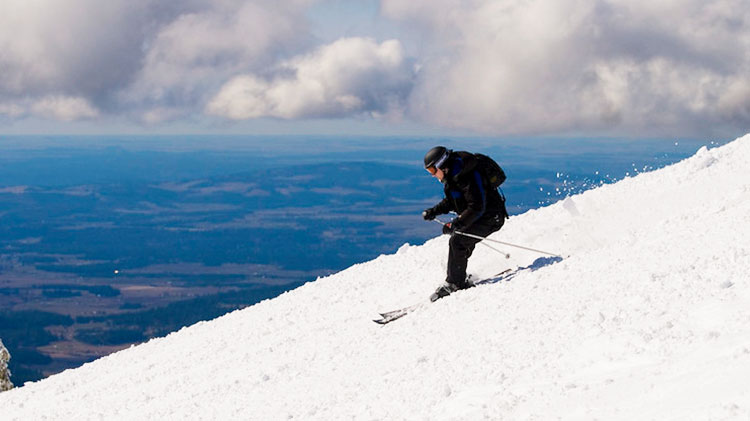Skiing blue runs are the second step in a skier’s progression. It can feel daunting to step up from green slopes but fortunately, we’ll guide you along as you make the step up.
First, for the newer skiers, let’s gauge how hard blue ski runs are and then we will teach you how to ride them successfully.

What Are Blue Ski Runs?
Head to just about any ski resort and you’ll find blue ski runs or trails. The thrill of skiing down a blue ski run is a feeling that can’t be described. It’s something that you have to experience for yourself.
Blue ski runs are intermediate-difficulty slopes that are perfect for skiers who are looking to improve their skills. They offer a great challenge while still being accessible to newer skiers who have had some ski lessons.
Blue ski runs step it up from the flatter green slopes and really start to offer a bit of steepness. This increased steepness requires more technical skill than riding a green slope.
How Steep Is a Blue Ski Run?
Ski runs come in all sorts of shapes and sizes, from wide, gentle slopes to narrow, steep chutes but blue slopes have a range of grades. Each blue trail is set by the resorts so you may find a very steep blue at one resort and then head to another resort and find that the blue trails are much easier to ride.
In North America blue trails often have an angle between 14 to 22 degrees. This is a bit steeper than Europe where blue runs range from 11 to 17 degrees. Keep in mind that North America and Europe don’t label their trails the same.
Are Blue Trails Hard?
Put any beginner on a blue trail and they will fail. If you have had proper instruction, lessons and have been skiing for a bit then there is no reason you can’t ride a blue trail. So if you asked a beginner if blue trails are hard, they would likely say yes. Asking a skier who has been skiing for a full season will likely tell you otherwise.
How Long Does it Take to Learn to Ski Blue Runs?

We already know how long it takes a skier to learn how to ski greens but what about blue runs?
It usually takes beginner skiers several days or even weeks to learn how to ski blue runs proficiently. We don’t recommend even trying a blue unless you are confidently riding all the green trails.
There are a few things that you can do to speed up the learning process. Firstly, make sure that you take the time to learn the basics of skiing before moving on to blue runs. Secondly, practice as often as possible; the more you ski, the better you will become.
And finally, don’t be afraid to ask for help from more experienced skiers. This can be a friend or in the form of a lesson. Both will speed up your progress to getting to blues.
How to Ski A Blue Run (Step by Step)
Skiing any trail level can be broken down into a step-by-step process and skiing blues is no different.
Let’s look at the gear and skills you need to ride a blue.
Ski Gear Needed to Ski Blue Trails:
- Medium turn radius skis (15-20 m) Here’s why they are important.
- A helmet – don’t ski blues without one!
Skiing Skills Required to Ski Blue Trails:
- Linking turns
- Can confidently control speed
- Able to stop when needed
Once you have all that in order, you will be ready to ski blue runs.
- The first step is finding a blue run. Look for a sign that says “blue square” or something similar. Once you get to the top, get a read on the run before dropping in. This means, waiting for any traffic to clear and visualizing where you will make your turns.
- Commit to the run and put in your first turn. You will want to lean forward and start linking turns.
- Control your speed throughout your descent to maintain safe riding.
- Keep your head up and continue to read the terrain and traffic while linking your turns down the blue until you complete the run.
Blue Ski Runs: Are They Dangerous?

Blue ski runs have a bad reputation for being dangerous but this is because too often beginners find their way onto blue slopes when they aren’t ready. With the right precautions, blue ski runs can be just as safe as any other run on the mountain.
As with any run, you should always have your helmet on. You might be a safe rider yourself but there is always traffic coming down from uphill.
Before skiing on a blue run, you should be comfortable on green runs and have some experience skiing in control. It is also important to know your limits and to ski within them. Blue runs can be more challenging than other runs, so it is important to take your time and stay in control.
If you need to stop going down a blue run and assess then do so at the side of the trail.
If you follow these tips, you can enjoy skiing on blue runs without putting yourself at risk or others/ Just remember to always stay aware of your surroundings and be prepared for anything that might happen.
Is a Blue Run A Lot Harder Than a Green Trail?
There seems to be a general consensus amongst skiers that blue runs are harder than green trails. It all comes back to the angle of the slope, otherwise the grade. Blue runs are certainly harder than green runs. They will bring out the skill in you and are a test for anyone moving up from beginner slopes.
One thing is for sure: blue runs definitely require more technical skill and experience than green trails. If you’re a beginner, it’s best to start out on easy trails and work your way up to the more challenging ones.
Final Thoughts on Skiing Blue Trails
Skiing blue trails is a natural progression for skiers. It may seem intimidating but over time, you will be ready. Make the most of lessons and other experienced skiers so you can quickly learn how to ski blue runs.
Once you “get it”, you will open up a lot more terrain to ride at the ski resorts!

Alec Wilson writes for Proper Peaks and lives near Claremont, VT. He hardly misses a weekend on the ski slopes in the winter. If there is snow, Alec’s skis are on for a go. Look out for his stickered-up helmet and you might just meet him on the trails.


